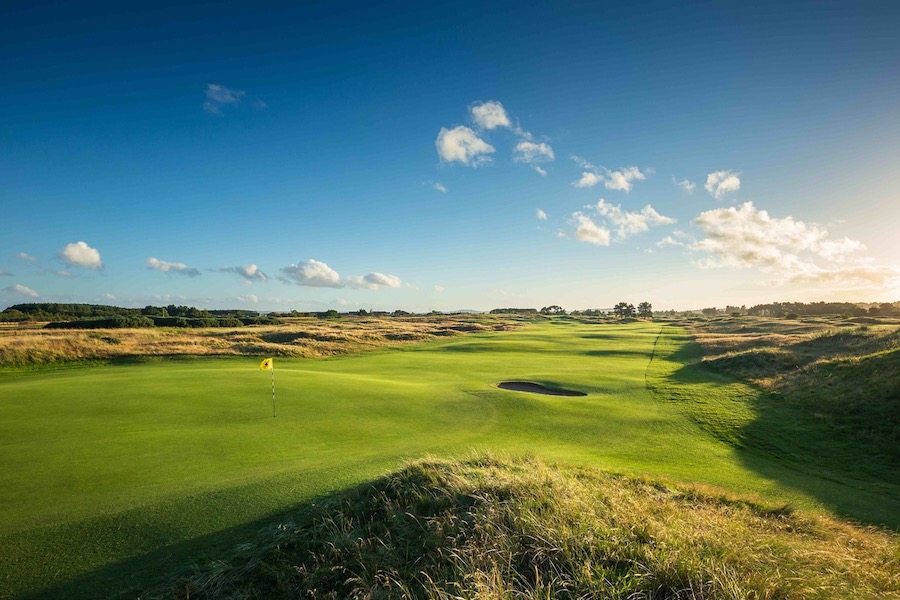Walk in the steps of legendary Ben Hogan, where he prepared for his 1953 Open victory
American golfers naturally gravitate to Scotland as one of their top bucket list destinations. The home of golf features such iconic golf experiences as The Old Course at St. Andrews, Royal Dornoch, Muirfield, Prestwick, North Berek, Carnoustie Golf Links, and the site of The Open Championship this week, Troon, to name a few.
While these historic venues top any golfer’s list, Scotland is also home to hundreds of other wonderful under-the-radar courses that are rich in history and provide an authentic Scottish golf experience. One of those must-plays is Panmure Golf Club, located only 1.5 miles from Carnoustie and a 45-minute drive from St. Andrews.
Celebrating its 125th anniversary (1899) in 2024 at its current site in Barry, Panmure is the world’s 21st oldest golf club. The original layout was designed by Old Tom Morris and constructed by R. Duff of Edinburgh, who also built the New Course at St Andrews and Muirfield.
Many of the original holes remain. In the 1920s, five-time Open champion James Braid suggested modifications that became the most significant updates to Panmure over the past century. As a result, some of the charming characteristics include holes designed by these greats: Braid’s par-3, 180-yard 9th hole, with its undulating green protected by large bunkers and dunes, and Old Tom’s par-4, 396-yard 12th hole, which requires an accurate approach shot to carry the Buddon Burn guarding the front of the green.
Today, Panmure is a timeless experience with its authentic course and clubhouse. The par-70 course measures 6,551 yards and combines the best elements of links and heathland with tight fairways, challenging carries, and undulating greens. True to links golf, holes play mostly firm and fast while the rolling fairways wind through dunes and pine trees, leading to greens protected by proper Scottish bunkers.

Panmure has hosted many prestigious championships, ranging from national amateur tournaments to final qualifying for The Open Championship. It’s also the 2024 qualifying venue for the Seniors Open at Carnoustie. Plus, it was recently nominated for best £100-to-£250 green fee course at the Scottish Golf Tourism awards and is ranked No. 34 among Golf World’s Top 100 Courses in Scotland. Golf Digest also ranks it No. 32 in Scotland on its list of The Best Golf Courses in Every Country.
Panmure’s iconic clubhouse is also one of the finest old golf buildings in Scotland. It was modeled—both architecturally and spiritually—after Royal Calcutta Golf Club. It offers three uniquely charming lounges, perfect for a post-round beverage.
Golfers can walk the fairways of Ben Hogan
Ben Hogan only played in one Open Championship, but he left an indelible mark on Scotland’s east coast because of how he won the game’s oldest major and how he prepared for it.
The Hawk famously captured the 1953 Open at Carnoustie Golf Links by shooting a final-round 68 while battling the flu. He topped four men by four shots in his lone voyage to Scotland, which came four years after an automobile accident that nearly killed him.

That journey, however, began two weeks earlier when Hogan, accompanied only by his caddy, Cecil Timms, arrived at Panmure to acclimate to the terrain of links golf and acquaint himself with the smaller 1.62-inch British ball used at the time.
Hogan was the only participant in the Open given the privilege of playing at Panmure, which at the time was an extremely private club. He was able to practice away from the prying eyes of the public and press.
He would never play in the Open again, but his legacy at Panmure remains. The 6th hole, a 414-yard par 4, stroke index 1, was Hogan’s favorite on the course and is now named after him. He suggested to the club that a strategically placed pot bunker be built to the front right of the green. It was and it is still known as Hogan’s bunker.
The other legendary story from Hogan’s Panmure experience came on the par-4, 401-yard 17th. Hogan liked the green and spent much time putting there, but he wanted it to run quicker. So he asked head greenskeeper William Falconer if the mower could shave the green a tad tighter. Falconer said it was possible, but pointed to the mower and mentioned that Hogan was free to do it himself. He did, and word is that he later returned the mower to Falconer in pristine condition after insisting on cleaning it first.

Hogan never returned to Scotland, and the victory at Carnoustie marked the last major he’d ever win. The Scots still refer to him as the “Wee Ice Mon” because of his steely demeanor, determination, and ability to perform best under pressure. The Open victory, combined with his presence at Panmure during the preceding weeks, were enough for Hogan to forever remain a legend in the area.
Panmure remains a private member’s club, but welcomes visitors to experience the authentic, classic links. Are you ready to take on the Hogan challenge?
Visit https://www.panmuregolfclub.co.uk




